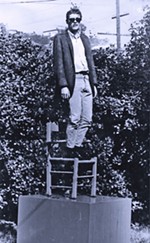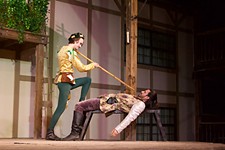Exhibitionism
Court 6: Bouncing Balls of Joy
Fri., Feb. 27, 1998
Running Time: 50 min

There's just something appealing about dancers trapped in a glass box. Like watching fish in an aquarium, seeing the dancers in there, in a specialized atmosphere, as opposed to out here conveys a sense of mystery and meditation. In fact, I wouldn't be very surprised to discover that audience members for Court 6 are able to enter the same slow-cortical wave state that are known to have been generated in those who stare into fish tanks.
Which is odd, given the sheer amount of fun that the performers in this Sharir Dance Company production seem to be having. No angst for these fish, no luxurious movements in and through an underwater paradise. Instead, these dancers bounce about a racquetball court much like the little blue balls that usually speed through this unique performance space. And, like these rubber spheres, the dancers are not afraid to explore all of the space, from 15 feet up the glass walls to the unplayable corners and smooth wooden floor.
Which makes it difficult to describe the experience of Court 6. It goes beyond the athletic shapes, which range from walking up the walls to bounding into a partner's arms, and enters an ethereal realm enhanced by some Gregorian chant and the cathedral-like feel of the glass. José Luis Bustamante's choreography defies summation in conventional terms and begins to enter the realm of magic. But it is a physical magic, made flesh by William Meadow's sound design, which picks up every footstep and exhalation the dancers make within the glass box. And the technical excellence of dancers Marika Chandler, David Chao, Bryan Green, Terry Hardy, Luis Manuel Narvaez, Carolyn Pavlik, and Liza Travis cannot be overstated. Their immaculate timing and driving athleticism make this production border on amazing.
Which really doesn't tell you how much fun the whole thing is. The dance may be serious in terms of the amount of preparation that went into it – including waking up at cruel hours in order to access this UT Recreation Center court when it was unoccupied – but it is not serious in the sense that it is unintelligible to those unfamiliar with more esoteric forms of dance. Nor does it take itself seriously and come with an air of stuffy high culture that can't laugh at itself.
Which makes it hard to leave the space after the performance has ended. You feel as if you have been privileged to experience this production. The dancers' joy almost bubbles from behind the walls and infects those watching. In return, the joy the audience develops from witnessing this extraordinary piece flows back into the performers through the glass, subtly reverberating with the magnetic movements happening behind the walls. – Adrienne Martini
BEAST ON THE MOON: HEAVY BAGS
State Theatre,through March 15
Running Time: 2 hrs, 30 min

Even in the best of situations, marriage is hard. Anyone who tells you differently is probably a divorce lawyer or Donald Trump. Marriage is more than simple love; it's also a collection of the baggage of the past, baggage that is generally not content to sit by unopenedand remain out of a new relationship. Of course,some people enter a marriage with only a small travel case, others with two tons of Samsonite that require the skill of three or four porters to get it in the door.
Above all else, Beast on the Moon is about a marriage. Richard Kalinoski's script takes us back to the early 1920s, when Seta and Aram Tomasian are struggling to learn how to live together, a process complicated by the fact that they had not met before they wed. Seta was a picture bride, a wife picked by Aram on the basis of a photograph and some letters, and Aram saves her from certain death by bringing her to this country. But that is the smallest of their concerns. The larger problem is the size of their baggage, a huge pile that is difficult to see around, despite the couple's best attempts to ignore it.
The packer of this luggage is the Turks. The Tomasians are Armenian and, like a lot of Armenians who came to the U.S. during this period, they lost most of their families in horrific ways during the Turks' jihad against this Christian community. Mothers and fathers were beheaded and crucified, children raped and starved by bands of Turks who formerly were their neighbors. This Live Oak Theatre at the State production uses black-and-white slides, projected on the proscenium, to show the horrors these families faced, a technique that sets a perfect tone for the action that will unfold as the Tomasians deal with their grief and anger.
Ken Webster gives an incredibly strong performance as Aram, turning this character who could be amazingly unlikable into a person whose motivations you understand, even though you may not condone his actions. Boni Hester is a delight as Seta, playing age 15 as effortlessly as 30 and filling her performance with touching nuance and grace. Everett Skaggs does the best he can – which is quite a lot – with his cipher of a part as the narrator who introduces us to the Tomasians and fills us in on all the details of their life.
Despite these strong performances and Rory McClure's soft but perfect lights and Buffy Manners' appropriate period costumes, it is Kalinoski's script that ultimately disappoints. The story is inherently dramatic and points up a historic, bloody episode about which many never learned. But the script spends far too much time using devices like Skaggs' narrator to tell us about the story and not enough time actually showing us what the consequences were. While Kalinoski develops Seta and Aram fairly well through narration and actual dialogue, the text keeps dipping into a big old bag of clichés, such as the story of Vincent, played by Brandon Howe, an orphan who needs a family and is befriended by Seta. This and other gee-willikers moments just don't ring true and continually kick the audience out of the reality of the world the playwright has worked to create. It proves once again that playwriting is just as difficult as marriage. – Adrienne Martini








